Intel Shares Alder Lake Pricing, Specs and Gaming Performance: $589 for 16 Cores
Intel whipped the covers off its Alder Lake processors today at its Innovation 2021 event, finally sharing the official specifications, pricing, and gaming and application performance details for its high-end desktop PC processors that will soon vie for a spot on our list of Best CPUs for gaming. Intel's initial Alder Lake salvo starts with three chips and their graphics-less variants, with the flagship $589 Core i9-12900K, which Intel bills as the 'world's fastest gaming processor,' leading the charge with 16 cores and 24 threads. Intel claims this chip provides an average 13% generational jump in gaming performance, beats AMD's Ryzen 9 5950X flagship by up to 30% in gaming, and offers up to twice the performance of its predecessor in content creation workloads. Intel even claims up to an 84% generational gain in fps in some game streaming scenarios.
Intel also announced its $409 Core i7-12700K and $289 Core i5-12600K chips that bring impressive gen-on-gen performance and core count improvements, but at the same pricing as their previous-gen counterparts.
Alder Lake represents the most disruptive change to Intel's chip designs in the last decade. Alder Lake's new hybrid x86 architecture uses Performance cores (P-cores) for high-priority lightly-threaded work (Golden Cove architecture) and Efficient cores (E-cores) for background and heavily-threaded tasks with the power- and area-optimized Gracemont. The Alder Lake-S desktop chips also support the leading-edge DDR5 and PCIe 5.0 standards that offer a big increase in throughput, giving Intel the lead in desktop PC connectivity.
It's been six long years since Intel launched its first 14nm processor, but Alder Lake also marks the beginning of the 'Intel 7' era for desktop PCs. We previously knew this manufacturing tech as 10nm Enhanced SuperFin, but Intel recently renamed its process nodes to match industry nomenclature (technically, this is the second generation of Intel's 10nm process). Intel 7 debuts in the Alder Lake processors and brings density, power, and performance enhancements over the ancient 14nm process.
The Alder Lake chips are available for preorder today, but they won't ship until November 4, 2021. For now, Intel has given us lots of new information, including deep-dive details on pricing, performance, motherboards, memory, and new overclocking bells and whistles. We can also share pictures of the chips.
Notably, Intel also disclosed that Alder Lake could suffer from 'performance variability' in Windows 10. It has also decided to part ways with its TDP ratings and recommendations, instead providing a new naming scheme and guidelines. We'll cover all of that here and on the following pages, but it's clear that Alder Lake reignites the AMD vs Intel battle in a very big way.
Intel Alder Lake Specifications and Pricing
Intel is only bringing its priciest parts to the retail market at first, but it is also shipping 28 more SKUs to OEMs for delivery in systems that will debut in early 2022. Intel hasn't shared the details of those models. We have deep-dive coverage of the Alder Lake SoC design and core microarchitectures here, along with a more broad overview in our Alder Lake all we know article.
As a quick overview, Intel has dispatched with the 'TDP' (Thermal Design Point) nomenclature, and now assigns a Processor Base Power (PBP) metric in its place. The company also added a secondary Maximum Turbo Power (MTP) metric to its spec sheets to quantify the highest power level during boost activity (typically called PL2). We have more detail on the following pages.
| Row 0 - Cell 0 | U.S. Price | Cores | Threads | P-Core Base/Boost | E-Core Base/Boost | TDP / PBP / MTP | DDR4-3200 | L3 Cache |
| Ryzen 9 5950X | $799 | 16P | 32 threads | 3.4 / 4.9 GHz | - | 105W | DDR4-3200 | 64MB (2x32) |
| Core i9-12900K / KF | $589 (K) - $564 (KF) | 8P + 8E | 16 Cores / 24 threads | 3.2 / 5.2 GHz | 2.4 / 3.9 GHz | 125W / 241W | DDR4-3200 / DDR5-4800 | 30MB |
| Ryzen 9 5900X | $549 | 12P | 24 threads | 3.7 / 4.8 GHz | - | 105W | DDR4-3200 | 32MB (1x32) |
| Core i9-11900K | $549 | 8P | 16 threads | 3.5 / 5.3 GHz | - | 125W | DDR4-3200 | 16MB |
| Core i7-12700K / KF | $409 (K) - $384 (KF) | 8P + 4E | 12 Cores / 20 threads | 3.6 / 4.9 GHz | 2.7 / 3.8 GHz | 125W / 190W | DDR4-3200 / DDR5-4800 | 25MB |
| Core i7-11700K | $409 | 8P | 16 threads | 3.6 / 5.0 GHz | - | 125W | DDR4-3200 | 16MB |
| Ryzen 7 5800X | $449 | 8P | 16 threads | 3.8 / 4.7 GHz | - | 105W | DDR4-3200 | 32MB |
| Core i5-12600K / KF | $289 (K) - $264 (KF) | 6P + 4E | 20 Cores / 16 threads | 3.7 / 4.9 GHz | 2.8 / 3.6 GHz | 125W / 150W | DDR4-3200 / DDR5-4800 | 16MB |
| Core i5-11600K | $272 | 6P | 12 threads | 3.9 / 4.9 GHz | - | 95W | DDR4-3200 | 12MB |
| Ryzen 5 5600X | $299 | 6P | 12 threads | 3.7 / 4.6 GHz | - | 65W | DDR4-3200 | 32MB |
All Alder Lake chips support DDR4-3200 or DDR5-4800, but caveats listed further below apply.
Intel's $589 16-core Core i9-12900K comes with eight P-cores that support hyper-threading, and eight single-threaded E-cores for a total of 24 threads. That's a 33% increase in thread count over the previous-gen Core i9-11900K. The P-cores have a 3.2 GHz base, and peak frequencies reach 5.2 GHz with Turbo Boost Max 3.0 (this feature is only on P-cores). This chip comes with 125W PBP (base) and 241W MTP (peak) power ratings.
The 12900K has a 100 MHz reduction in peak clock frequency compared to the 11900K, but that isn't too meaningful given the entirely new hybrid architecture — these chips will realize performance gains from using different core types for different tasks. Speaking of which, the E-cores have a 2.4 GHz base and stretch up to 3.9 GHz via the standard Turbo Boost 2.0 algorithms. The chip comes armed with 30MB of L3 cache and 14MB of L2.
At $589, the Core i9-12900K comes at a $40 premium over its prior-gen counterpart, squeezing in between the $799 16-core Ryzen 9 5950X and $549 Ryzen 9 5900X. That could be attractive if Intel's performance claims pan out (more later), but it leaves a sizeable $185 gap between the Core i9 and i7 families that Intel inadequately plugs with the graphics-less $564 Core i9-12900KF. It's logical to expect a filler product between Core i7 and i9 in the future (possibly like the Core i9-10850K).
The $409 Core i7-12700K comes with the same $409 tray pricing as the previous-gen Core i7-11700K and has eight P-cores and four E-cores, for a total of 20 threads. The P-cores run at a 3.6 / 5.0 GHz base/boost, while the E-cores weigh in at 2.7 / 3.8 GHz, all fed by 25MB of L3 cache and 12MB of L2. The graphics-less $384 Core i7-12700KF comes with a $25 price reduction.
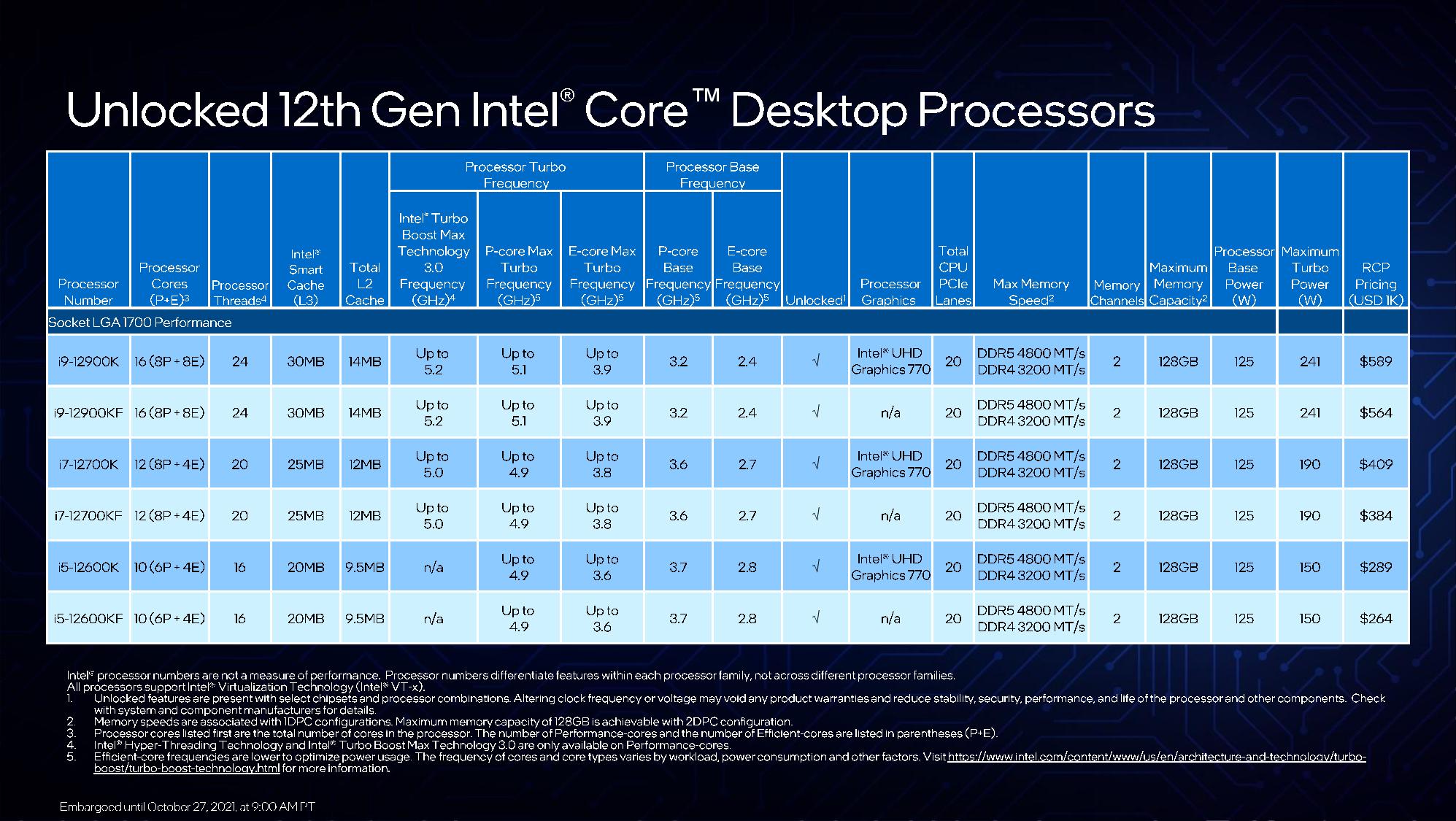
The 12700K's $409 price point means that Intel has kept the Core i7 flagship at its same price point, where it lands between the $449 Ryzen 7 5800X and $399 Ryzen 5 5600X. The 12700K/F's increased performance could make it a more attractive part than its lackluster previous-gen counterpart, the hard-to-recommend Core i7-11700K.
The Core i5-12600K's $289 price point remains the same as the prior-gen Core i5-11600K, meaning it lands right smack dab in gamer country, going toe-to-toe with the $299 six-core Ryzen 5 5600X and representing the lowest point of entry to the Alder Lake family (at least for now). This chip comes with six threaded P-cores that operate at 3.7 / 4.9 GHz and four E-cores that run at 2.8 / 3.6 GHz, for a total of 16 threads. That's paired with 20MB of L3 and 9.5MB of L2 cache.
AMD's competing Ryzen 5 5600X currently leads our Best CPU for gaming list, but it faces a stiff challenge from Intel's 12600K.
All the Alder Lake chips support both DDR4 and DDR5 memory, but there are several caveats to the listed DDR5 support. As a default, DDR5 runs in Gear 2 mode, resulting in higher latency, and standard motherboards only support DDR5-4800 if the motherboard has only two physical slots. Therefore, at stock settings, the chip will only support DDR5-4400 on any motherboard with four slots, even if only two slots are populated.
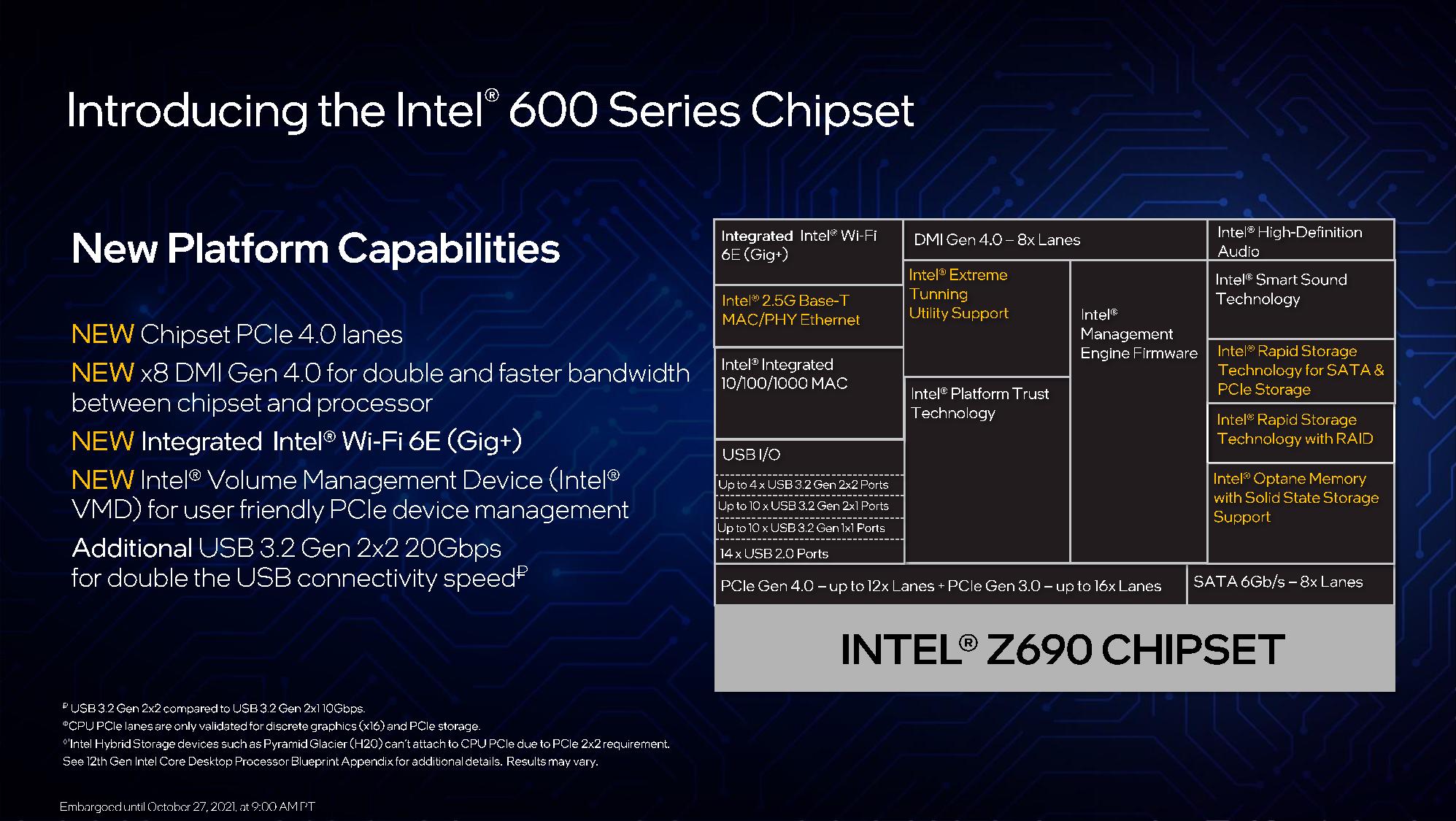
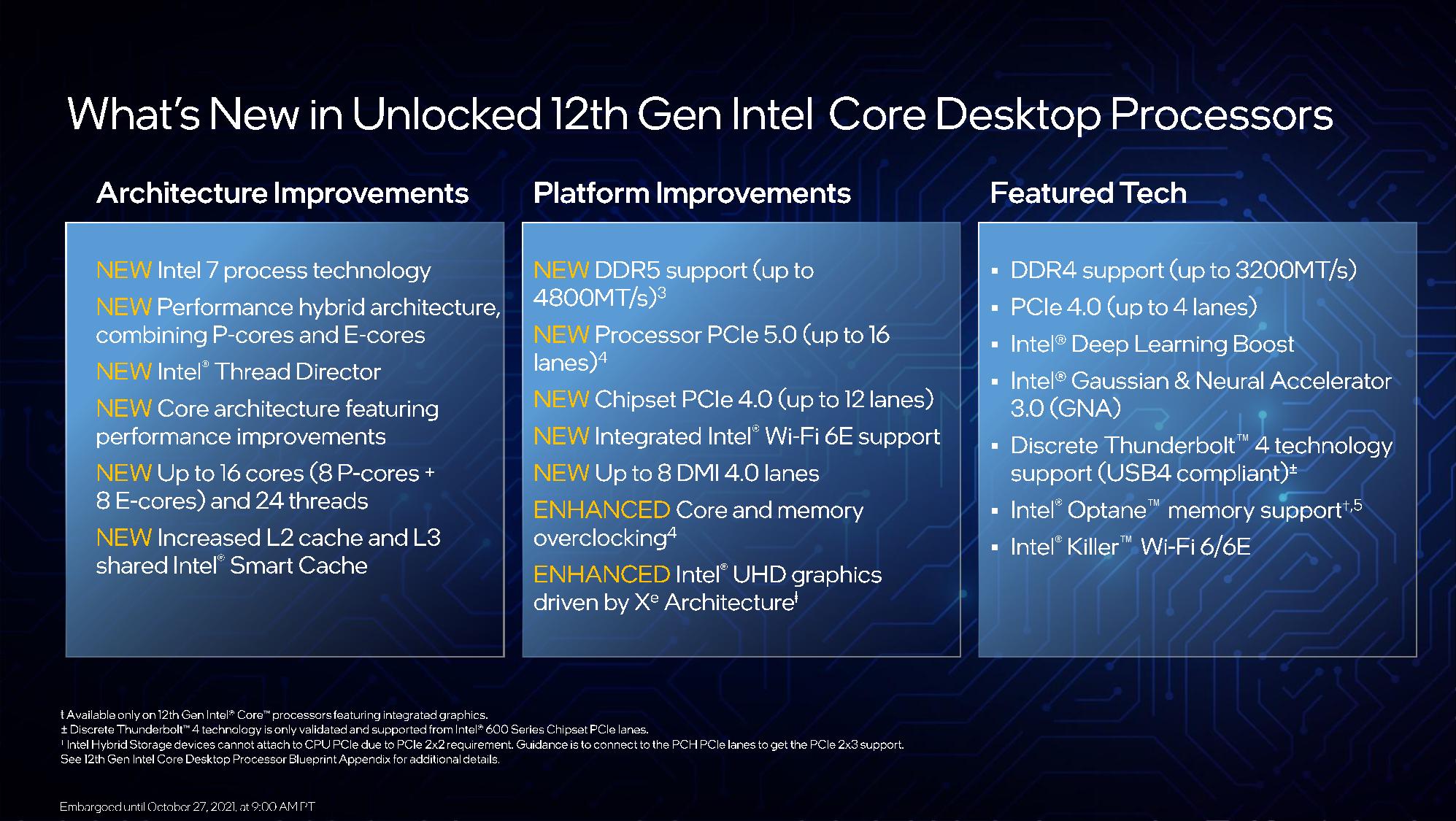
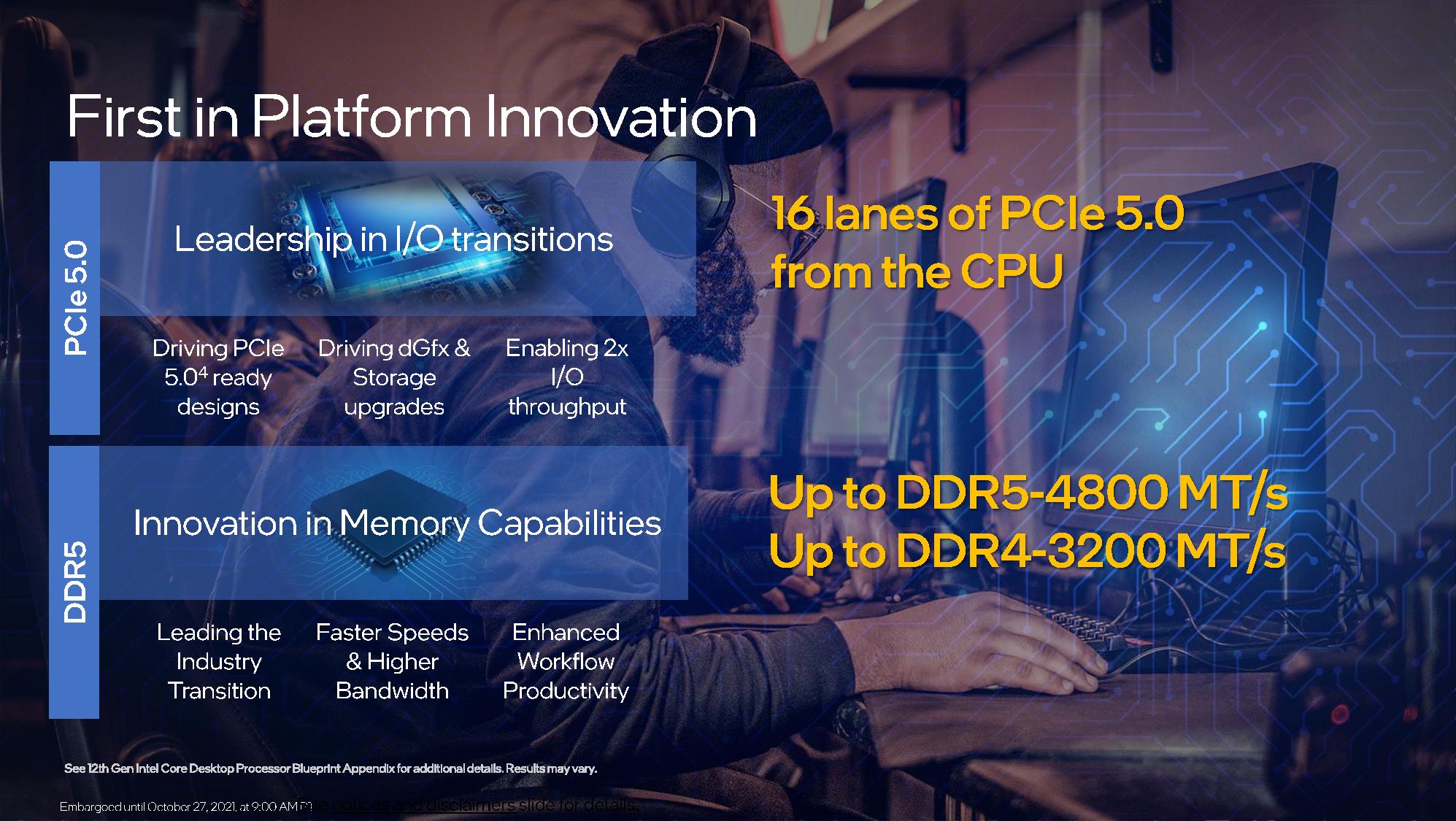
Intel also introduced its 14nm Z690 chipset as part of today's release, and you can read about the chipset and some of the first 60+ motherboards in our Z690 motherboard roundup here. There's a wide selection of DDR5 motherboards spread among the various motherboard makers' high- and lower-end Z690 families. However, DDR4 models appear to be confined to the lower-end Z690 boards (unlike previous generations, no motherboard supports both DDR4 and DDR5). We expect pricing for DDR5 to be substantially higher than DDR4, currently projected to be a 50 to 60% markup, for some time.
Alder Lake supports up to 16 lanes of PCIe 5.0 (technically for storage and graphics only, no networking devices) and an additional four lanes of PCIe 4.0 from the chip for M.2 storage. Intel has also added 12 lanes of PCIe 4.0 that hang off the chipset, a nice step up from the Z590 chipset's PCIe 3.0 support. That provides a total of 28 PCIe platform lanes for Alder Lake systems. Intel also doubled the throughput of the DMI connection between the chip and chipset from an x8 DMI 3.0 pipe, which clocks in at 7.88 GB/s, to an x8 DMI 4.0 connection that delivers 15.66 GB/s. Intel also added support for the Volume Management Device feature that enables PCIe SSD management and the ability to create bootable RAID configurations.
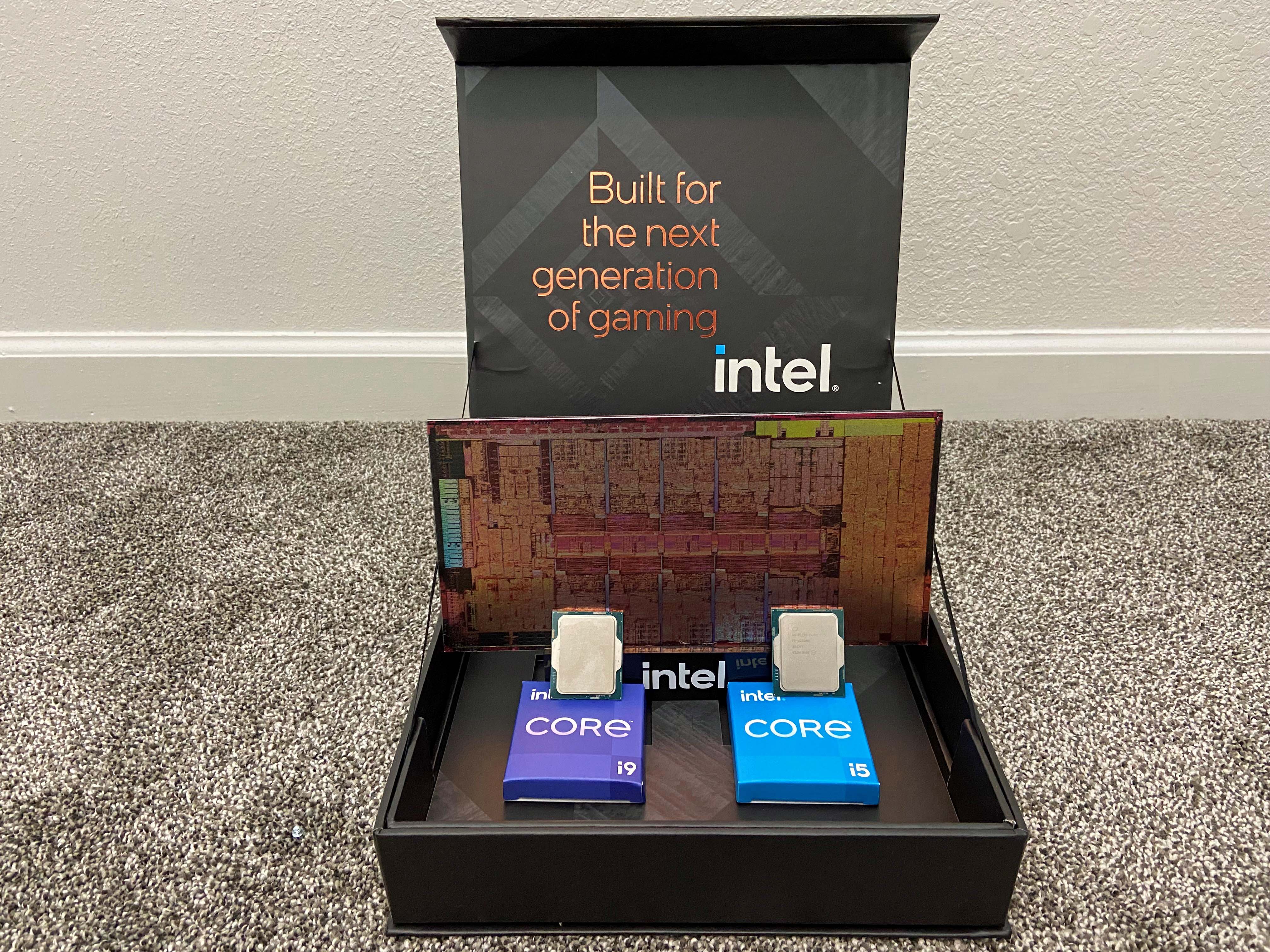
The K-series chips come with the UHD Graphics 770 engine that's effectively the same as the UHD 750 engine present on the Rocket Lake processors. The media engine, the same Gen12 Xe LP architecture found in Tiger Lake but ported to the Intel 7 process, comes with 32 EUs (GT1) for desktop PCs. The Xe LP engine supports limited 1080p gameplay and has a 12-bit end-to-end video pipeline.
The UHD 770 engine clocks in at (up to) 1550, 1500, and 1450 MHz for the 12900K, 12700K, and 12600K, respectively.
None of the Alder Lake chips support AVX-512. Instead, support is capped at AVX2. None of the 12th-Gen Core i3 models, and some Core i5 variants, will not come with a hybrid architecture, meaning they will only have P-cores. Much like we see with the Rocket Lake family, those lower-end chips could come with an older architecture.
Let's take a quick look at Intel's gaming performance claims and then the chips.
Get Tom's Hardware's best news and in-depth reviews, straight to your inbox.
Alder Lake Gaming and Application Performance Benchmarks
Intel has finally shared its first Alder Lake gaming benchmarks, but as with all vendor-provided results, take these with a grain of salt. Also, be aware that some of these benchmarks come from Intel-sponsored game titles. We have included Intel's test notes at the end of the article.
Intel tested its gaming performance with DDR5-4400 memory in Windows 11 but says that we can expect a comparable level of performance with DDR4 memory and/or Windows 10 (within a few percentage points either way, depending on the game). Intel claims that Alder Lake retains the performance lead over Ryzen regardless of the type of memory or OS used. However, Intel does recommend Windows 11 as the preferred option for Alder Lake. Windows 10 can introduce performance variability with Alder Lake, which we'll cover a bit more on the following pages.
For testing, the company used an Nvidia RTX 3090 GPU at the 1080p resolution — standard fare for CPU gaming benchmarks. Intel tested with Windows Defender and the performance-sapping Virtualization Based Security (VBS) feature active (you can see our testing of the impact of VBS on gaming here).

Intel measured performance against the Ryzen 9 5950X but admitted that it tested without the Windows 11 patch that fixes an L3 cache and boost clock issue with AMD's chips. Intel told us during briefings that it will retest with the patch once it is available (it has since become available) and update these benchmarks if there are any material changes. (We've tested the Windows 11 and AMD patches and haven't seen any drastic improvements in our own testing. Look for that article soon.)
Notably, as you can see in our CPU Benchmark hierarchy, the Ryzen 9 5950X effectively ties the 5900X as the fastest Ryzen 5000 chip in gaming at stock settings. We definitely don't recommend buying the 5950X only for gaming – instead, you should opt for the less expensive and just-as-potent Ryzen 9 5900X.
Intel's results point to the 12900K have a sizeable lead over the 5950X in seven titles, ranging from an 8% to 30% lead, along with a 3% loss in Shadow of the Tomb Raider and a tie in Crysis Remastered. Most of these titles are lightly threaded, so they don't benefit too much from Ryzen 9 5950X's core counts.
Intel says its losses/ties are typically in GPU-bound titles. The company pointed out that some titles, like Hitman 3, are already optimized to support running physics and background tasks on Alder's E-cores, boosting performance. Intel expects optimizations for the hybrid architecture to filter out to more game titles in the future, as latency-sensitive tasks like rendering perform best on P-cores while hybrid-aware engines can shuffle background tasks like physics and audio to the E-cores. Optimizations for hybrid architectures can vary, though: For instance, Mount and Blade is optimized to run on all cores for the best performance.

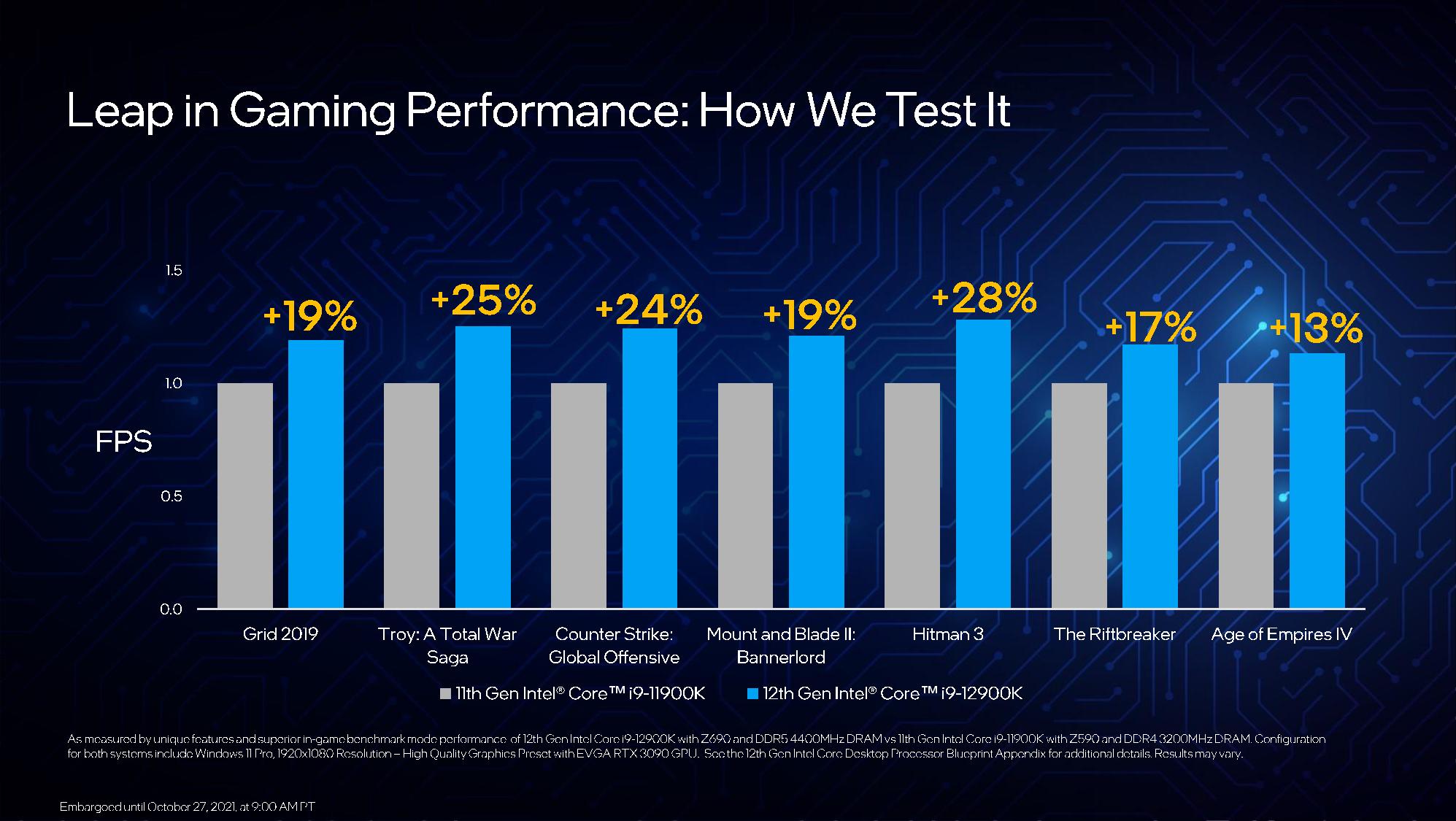

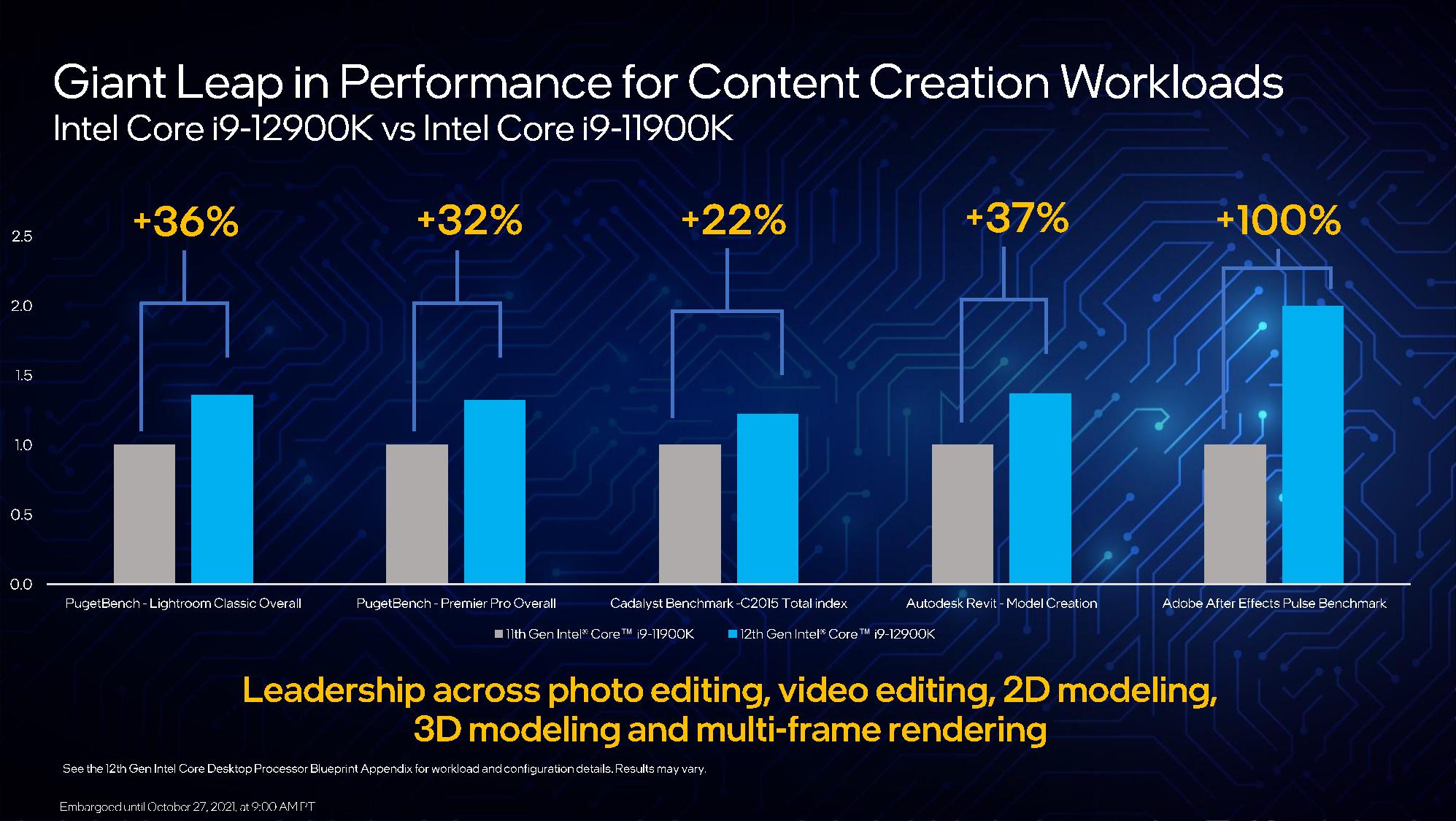

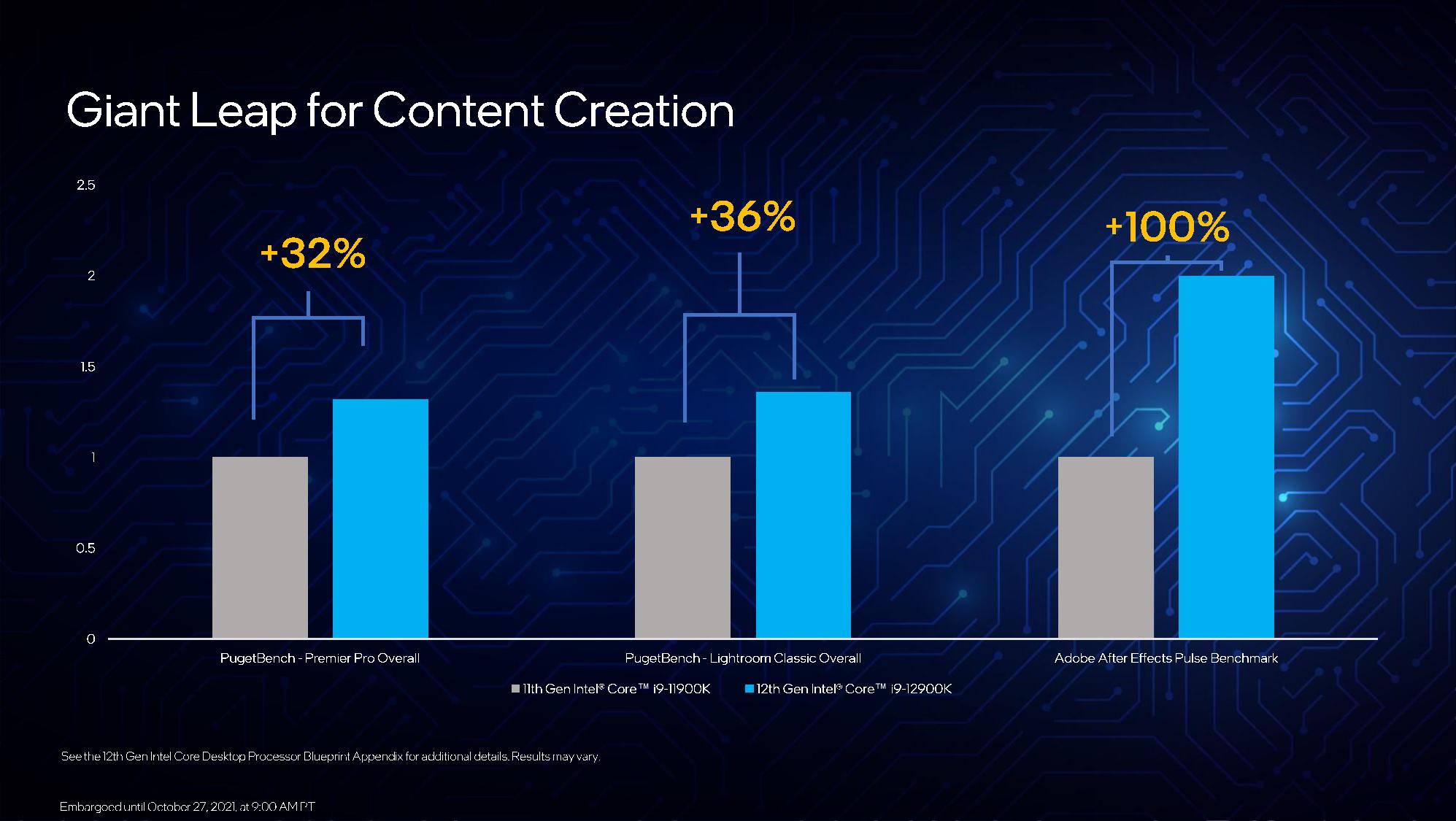
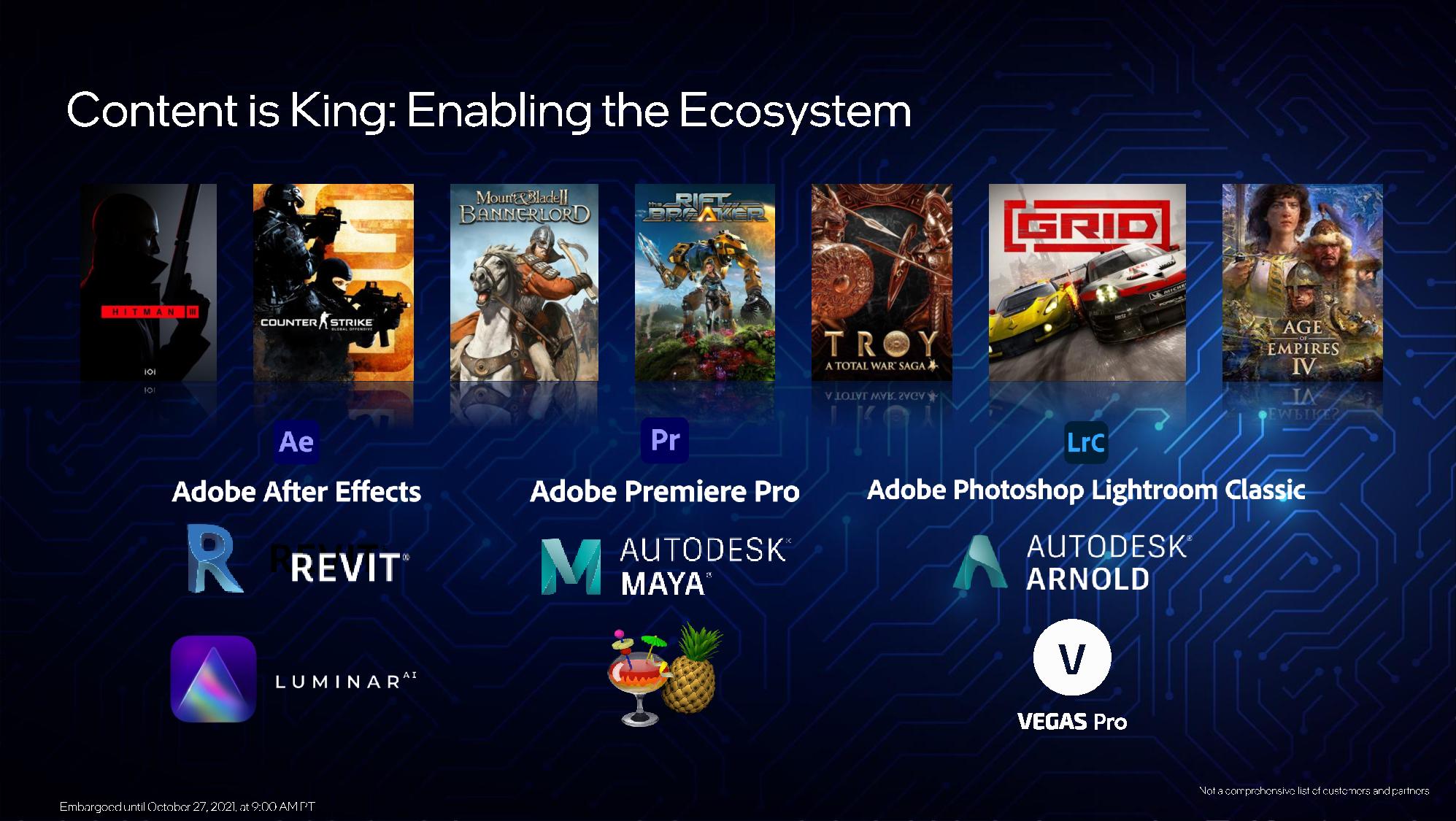
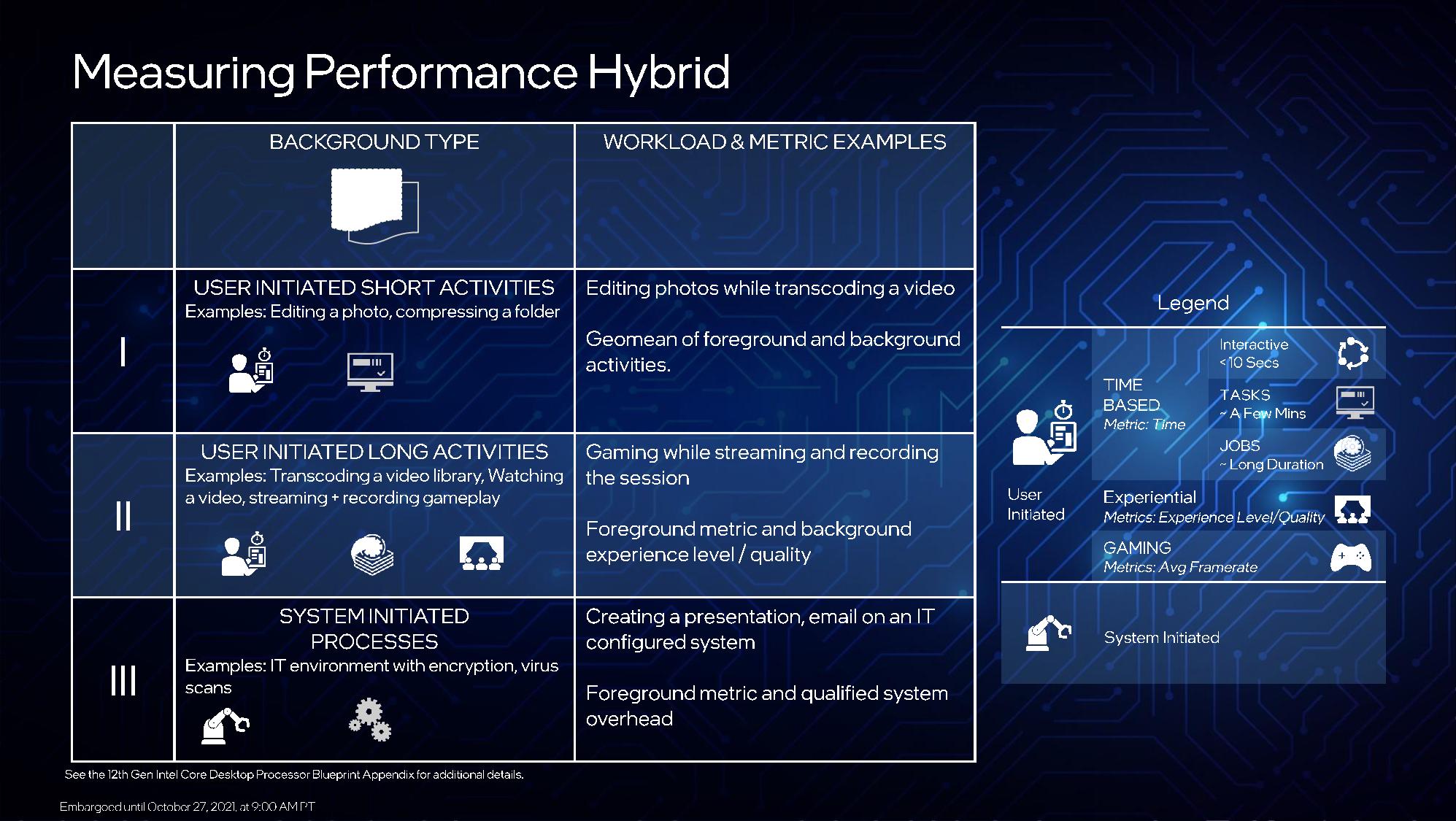
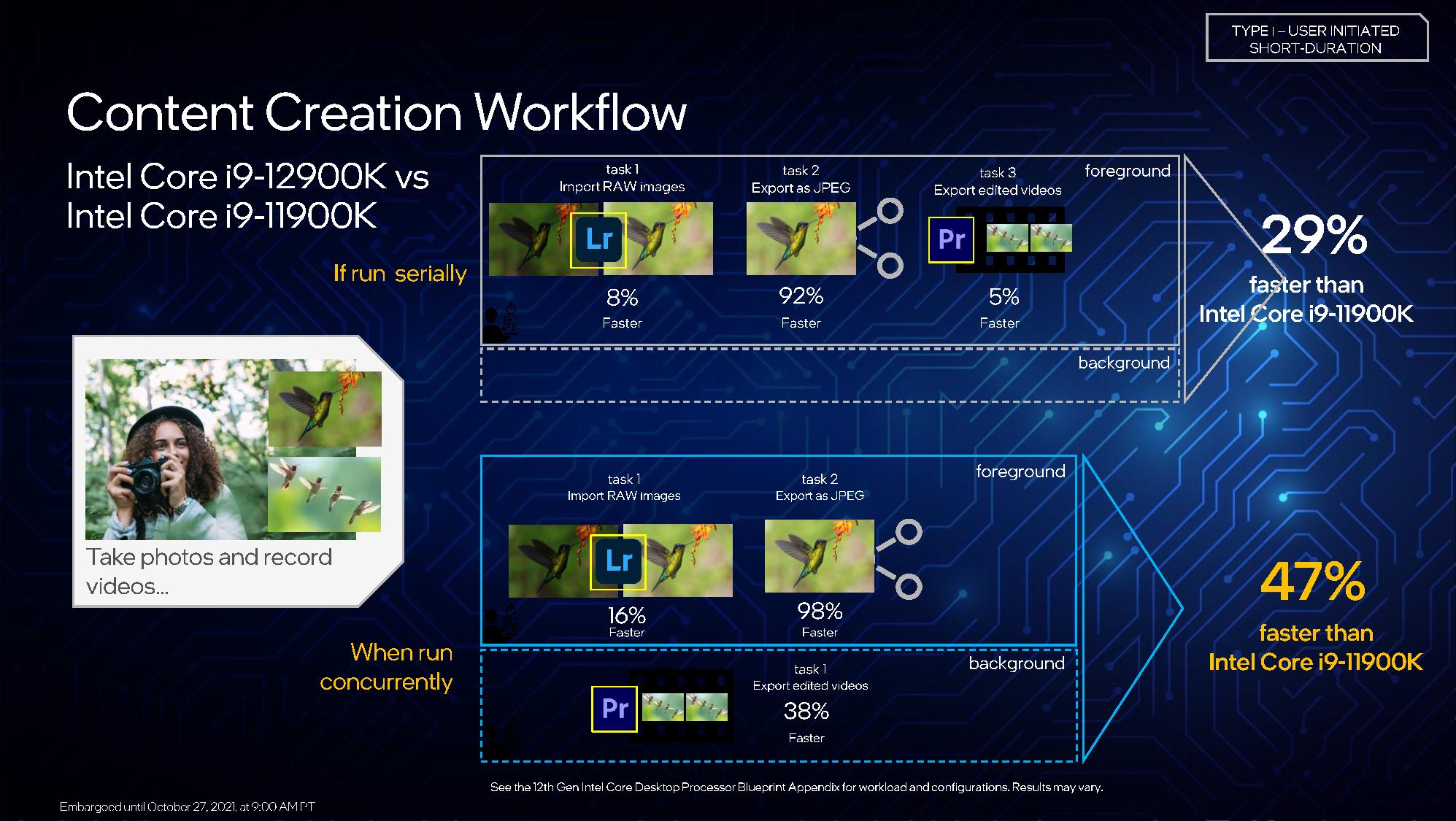
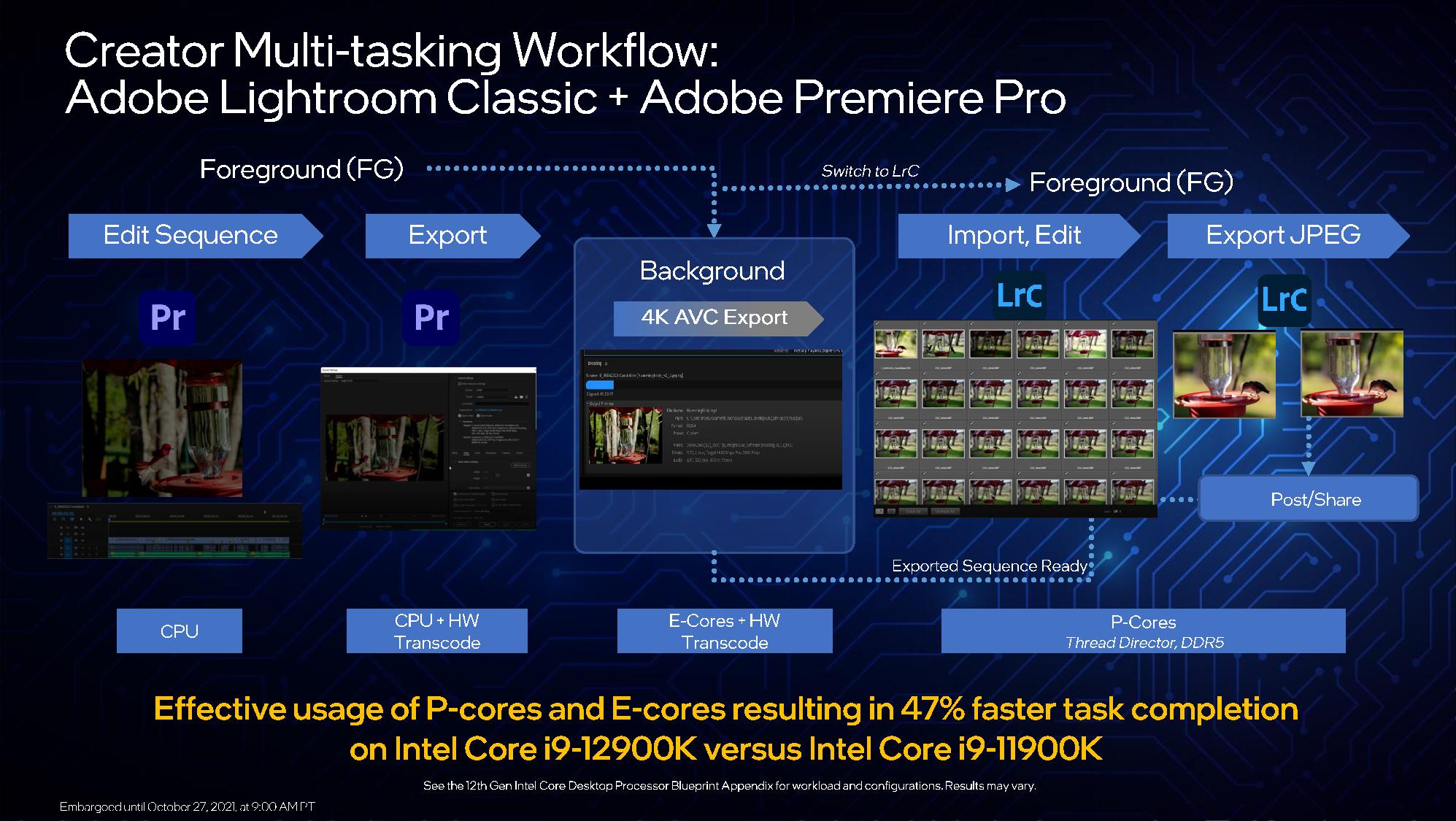

Intel chose to avoid Ryzen 5000 and compete with itself in most of its gaming and content creation benchmarks. Here we can see that the company put the Core i9-12900K head-to-head with the previous-gen 11900K and tested 31 game titles, with the 12900K coming out on top by a geometric mean of 13%.
Intel also displayed a multi-tasking workload that consisted of simultaneously gaming while streaming and recording with OBS, with the latter two functions running on the E-cores while the P-cores ran the game code. Intel claimed that the Core i9-12900K provided 84% higher fps than the 11900K during this test.
Intel's content creation benchmarks avoided any direct comparisons with AMD's competing processors and consisted entirely of applications that benefit from optimizations for hybrid architectures. That means these tests aren't indicative of what you can expect with most applications, but we'll suss that out in our coming review.
There will be teething pains, though. As we reported, Denuvo DRM falsely identified Intel's E-cores as a separate system, and thus 91 Denuvo-enabled game titles wouldn't work with Alder Lake chips. Intel has worked with Denuvo, and the software maker issued a flurry of game patches to fix the issue. However, 32 titles are still not patched.
Intel says 18 of those game titles land in the 'Top 100' list of Denuvo titles. Of those, sixteen have already been patched, with the remaining two slated for a fix by the end of the month. Intel says that all games should eventually work with Alder Lake.
Jump to the next pages for pics and analysis of Alder, as well as coverage on the new TDP paradigm, overclocking, and Intel's Thread Director.

Paul Alcorn is the Editor-in-Chief for Tom's Hardware US. He also writes news and reviews on CPUs, storage, and enterprise hardware.
-
wifiburger 589$ is awesome, very interestingReply
If I do upgrade I'll go with DDR4 since I already have a good 4400 bdie kit -
-Fran- Reply
That's the 1K tray pricing, not "plebian" MSRP.wifiburger said:589$ is awesome, very interesting
If I do upgrade I'll go with DDR4 since I already have a good 4400 bdie kit
At retail it'll definitely be more than that. Still, finding it under $700 may be totally possible, so good news there for sure. I'd say it's like at least 20% increase over the prices mentioned.
Seems like Intel is not going ballistic with pricing, so that also hints at them being cautious. Not a bad thing, TBH.
Regards. -
VforV As an AMD user all I care about Alder Lake is the price and I do hope these are the real prices on launch, even if these are only the mythical MSRPs, they should make AMD drop their Zen3 prices too.Reply
So that's good news if true, for me.
Also I like how in their own gaming benchmarks intel has a average of about +15% lead over Zen3, like the same gap Zen3 V-Cache will add. Not the +50% all the synthetic benchmarks and click-bait titles were shouting from the rooftops up until now... -
TerryLaze Reply
Yes and all the big chains that will buy way more than just 1k will get them for cheaper than that.Yuka said:That's the 1K tray pricing, not "plebian" MSRP.
First couple of weeks are going to be higher prices because that always happens, the big question is what will happen after that, if scalpers will be a big issue or if they are going to be sold for more by retailers. -
Roland Of Gilead 'The Alder Lake chips are available for preorder today, but they won't ship until October 4, 2021' - Am I stuck in a time warp! :tearsofjoy: So I could have ordered this 3 weeks ago!?Reply -
-Fran- Reply
I was told Microcenter already has it listed for $650.TerryLaze said:Yes and all the big chains that will buy way more than just 1k will get them for cheaper than that.
First couple of weeks are going to be higher prices because that always happens, the big question is what will happen after that, if scalpers will be a big issue or if they are going to be sold for more by retailers.
Regards. -
TerryLaze Reply
Looking at price history the 11900k was available at exactly the MSRP from day one, not everywhere but still, there is no reason to believe that the 12900k will be different, except for retailers that might take advantage of the situation.Yuka said:I was told Microcenter already has it listed for $650.
Regards.
https://pcpartpicker.com/product/mDcG3C/intel-core-i9-11900k-35-ghz-8-core-processor-bx8070811900k?history_days=365 -
-Fran- Reply
Not disagreeing. I mentioned Microcenter as they're usually your "best case scenario" for retail pricing.TerryLaze said:Looking at price history the 11900k was available at exactly the MSRP from day one, not everywhere but still, there is no reason to believe that the 12900k will be different, except for retailers that might take advantage of the situation.
https://pcpartpicker.com/product/mDcG3C/intel-core-i9-11900k-35-ghz-8-core-processor-bx8070811900k?history_days=365
Regards. -
hotaru251 kind of weird they knowingly posted benchmarks vs a nerfed ryzen os.Reply
should of just omitted it and posted fair ones later.
but props to em for mentioning it. -
nervousstate Reply
Not to mention everything else will be a premium at launch. PCIe5 and DDR5 are not going to make motherboards more affordable and DDR5 is at least 2X the price of DDR4 and overclocking the memory to actually achieve a benefit is still very much unknown and different than DDR3/4 due to the change to the power delivery as well as everything else that is new. We are also going to see the extended L3 Cache launched very soon from amd which they suggested is going to have a 20% improvement along with 16 REAL cores for about the same price as the 5950X - It does look like they have improved Single threaded performance over AMD but youll never get the same performance with 8 Atom Cores. The i5 looks like a compelling offer though. 6C/12T + 4 Low-Power Cores is going to compete well against the 5600X and LP cores will be nice for running docker containers or network services without effecting gaming performance. Unless of course AMD drops the price a little...Yuka said:That's the 1K tray pricing, not "plebian" MSRP.
At retail it'll definitely be more than that. Still, finding it under $700 may be totally possible, so good news there for sure. I'd say it's like at least 20% increase over the prices mentioned.
Seems like Intel is not going ballistic with pricing, so that also hints at them being cautious. Not a bad thing, TBH.
Regards.